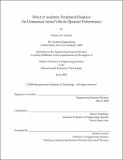| dc.contributor.advisor | Mary Cummings. | en_US |
| dc.contributor.author | Graham, Hudson D | en_US |
| dc.contributor.other | Massachusetts Institute of Technology. Engineering Systems Division. | en_US |
| dc.date.accessioned | 2008-12-11T16:56:38Z | |
| dc.date.available | 2008-12-11T16:56:38Z | |
| dc.date.copyright | 2008 | en_US |
| dc.date.issued | 2008 | en_US |
| dc.identifier.uri | http://hdl.handle.net/1721.1/43741 | |
| dc.description | Thesis (S.M.)--Massachusetts Institute of Technology, Engineering Systems Division, 2008. | en_US |
| dc.description | This electronic version was submitted by the student author. The certified thesis is available in the Institute Archives and Special Collections. | en_US |
| dc.description | Includes bibliographical references (p. 101-105). | en_US |
| dc.description.abstract | With advanced autonomy, Unmanned Aerial Vehicle (UAV) operations will likely be conducted by single operators controlling multiple UAVs. As operator attention is divided across multiple supervisory tasks, there is a need to support the operator's awareness of the state of the tasks for safe and effective task management. This research explores enhancing audio cues of UAV interfaces for this futuristic control of multiple UAVs by a single operator. This thesis specifically assesses the value of continuous and discrete audio cues as indicators of course-deviations or late-arrivals to targets for UAV missions with single and multiple UAVs. In particular, this thesis addresses two questions: (1) when compared with discrete audio, does continuous audio better aid human supervision of UAV operations, and (2) is the effectiveness of the discrete or continuous audio support dependent on operator workload? An experiment was carried out on the Multiple Autonomous Unmanned Vehicle Experiment (MAUVE) test bed with 44 military participants. Specifically, two continuous audio alerts were mapped to two human supervisory tasks within MAUVE. These continuous alerts were tested against single beep discrete alerts. The results show that the use of the continuous audio alerts enhances a single operator's performance in monitoring single and multiple, semi-autonomous vehicles. The results also emphasize the necessity to properly integrate the continuous audio with other auditory alarms and visual representations in a display, as it is possible for discrete audio alerts to be masked by continuous audio, leaving operators reliant on the visual aspects of the display. | en_US |
| dc.description.statementofresponsibility | by Hudson D. Graham. | en_US |
| dc.format.extent | 105 p. | en_US |
| dc.language.iso | eng | en_US |
| dc.publisher | Massachusetts Institute of Technology | en_US |
| dc.rights | M.I.T. theses are protected by
copyright. They may be viewed from this source for any purpose, but
reproduction or distribution in any format is prohibited without written
permission. See provided URL for inquiries about permission. | en_US |
| dc.rights.uri | http://dspace.mit.edu/handle/1721.1/7582 | en_US |
| dc.subject | Engineering Systems Division. | en_US |
| dc.title | Effect of auditory peripheral displays on unmanned aerial vehicle operator performance | en_US |
| dc.type | Thesis | en_US |
| dc.description.degree | S.M. | en_US |
| dc.contributor.department | Massachusetts Institute of Technology. Engineering Systems Division | |
| dc.identifier.oclc | 263167694 | en_US |
